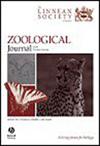Craniodental anatomy of Late Ruscinian Trischizolagus (Leporidae: Lagomorpha) from Megalo Emvolon (Thessaloniki, Greece)
IF 3
2区 生物学
Q1 ZOOLOGY
引用次数: 0
Abstract
During the Early Ruscinian, the leporid genus Trischizolagus (Leporidae: Mammalia) underwent a significant dispersion and increase in diversity, expanding from the peri-Paratethyan region to China, Spain, and Morocco. Its fossil record remains, however, poor, primarily comprising of isolated teeth, toothrows, and mandibles, while cranial material is extremely rare and often too fragmentary. The present paper presents a well-preserved and rich sample of Trischizolagus from the Megalo Emvolon-4 (MVL) fossil site near Thessaloniki (Greece) and provides for the first time the full cranial anatomy of T. dumitrescuae, the most common species known from the Late Ruscinian of SE Europe. The results allow an assessment of its intraspecific variation, while comprehensive craniodental comparisons fix some previous morphological misconceptions and provide additional distinctive cranial features with both extinct and extant Old World leporid taxa. Although a phylogenetic analysis failed to resolve the relationships of the genus, a review of its chronospatial distribution based on earlier hypotheses and new data confirms its debatable north Mediterranean Mio-Pliocene record and favors an origin closer to a dentally advanced Hypolagus population.希腊塞萨洛尼基Megalo Emvolon地区晚俄罗斯Trischizolagus (Leporidae: Lagomorpha)的颅齿解剖
在俄罗斯早期,三毛猴属(毛猴科:哺乳动物)经历了一次显著的分散和多样性的增加,从帕拉特提亚周边地区扩展到中国、西班牙和摩洛哥。然而,它的化石记录仍然很差,主要是由孤立的牙齿、牙齿和下颌骨组成,而颅骨材料极其罕见,而且往往太碎片化。本文介绍了在希腊塞萨洛尼基附近的Megalo Emvolon-4 (MVL)化石遗址中发现的一个保存完好且丰富的Trischizolagus样本,并首次提供了T. dumitrescuae的完整颅骨解剖结构,T. dumitrescuae是欧洲东南部晚俄罗斯人最常见的物种。研究结果允许对其种内变异进行评估,而全面的颅齿比较修复了以前的一些形态学误解,并为已灭绝和现存的旧大陆lepora类群提供了额外的独特颅特征。尽管系统发育分析未能解决该属的关系,但基于早期假设和新数据对其时空分布的回顾证实了其有争议的地中海北部中新世-上新世记录,并倾向于起源更接近于牙齿先进的hyppolagus种群。
本文章由计算机程序翻译,如有差异,请以英文原文为准。
求助全文
约1分钟内获得全文
求助全文
来源期刊
CiteScore
6.50
自引率
10.70%
发文量
116
审稿时长
6-12 weeks
期刊介绍:
The Zoological Journal of the Linnean Society publishes papers on systematic and evolutionary zoology and comparative, functional and other studies where relevant to these areas. Studies of extinct as well as living animals are included. Reviews are also published; these may be invited by the Editorial Board, but uninvited reviews may also be considered. The Zoological Journal also has a wide circulation amongst zoologists and although narrowly specialized papers are not excluded, potential authors should bear that readership in mind.

 求助内容:
求助内容: 应助结果提醒方式:
应助结果提醒方式:


